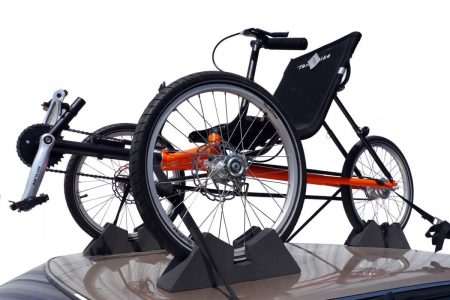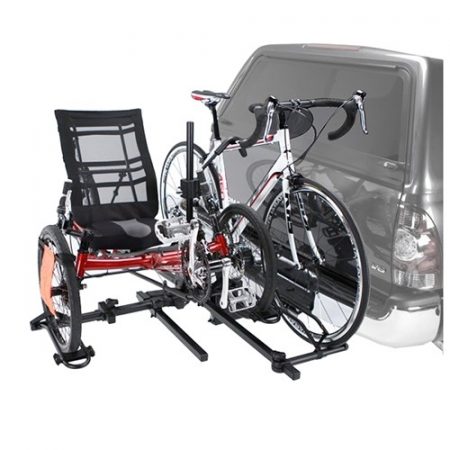I just bought a recumbent, how do I get it home?
People often come to our shop with the whole family, three dogs, vacation gear and a car with a trunk and decide they want to take a recumbent home with them. This article is designed to get you started thinking the logistics through of how you will transport your trike or bike to where you want to ride it.
The easiest way is put your recumbent in the vehicle. This works great if you have a SUV, truck or even a small hatchback. Usually a SUV will fit two folded recumbent tadpole trikes with a little wiggling and planning. With a truck the only thing you need to do is tie the recumbent down with a strap or bungie cord so the wind doesn’t fling it out at 70 mph on the thruway. The small hatchback will usually fit a trike with the rear seats down and the rear trike wheel either between the front seats near your elbow or positioned diagonally with the rear wheel aimed at the passenger door with the seat slid all the way forward.
The next level of difficulty are cars with trunks. Very few recumbents will fit in a trunk or squeeze thru the door opening of a back seat. If you get a folding recumbent bicycle like the Linear Limo or Roadster they will fit in the trunk or back seat of the tiniest compact cars with minimal fuss. The least expensive way to transport a non-folding short wheelbase recumbent or a tadpole trike is to use a traditional rear rack that straps to the trunk.
Most of the time a short wheelbase will strap onto the two “arms” with the use of some extra bungie cords or tie down straps. It’s best to remove the seat first if it is easy to do, if not, then use extra straps to the seat or the rear frame to keep the wind from making the bike tip or sway while driving. Watch out for having the chain rub the bike frame and scratch the paint. A little careful routing or an old rag will help with that. Long wheel base recumbents can be mounted the same way. The thing to take into consideration is if the bike extends past the car mirrors. Nothing would ruin your day faster than going through a toll booth or drive through and having your new bike get a smack or scrape along the concrete. Often removing the front wheel lets you re-center the bike on the rack to get the extra room you need.
Mounting a tadpole trike this way is possible with a slightly different technique. Imagine the rear wheel of the trike sitting on the roof and the cross member of the trike frame the front wheels attach to resting on the “arms” of the rack. Have the seat removed or folded all the way forward so it doesn’t catch the wind while driving. Next strap down everything tightly: the cross member to the “arms” and then figure out a way to tie down the rear wheel to the trunk or the rack. This isn’t the way I would do this if I had a choice, it’s more the “hail Mary” way to just get it home the first time and come up with something better long term.
A safer way would be to buy the Terratrike Universal Trike Carrier for around $120. It consists of three anti-slip foam blocks and some kayak straps that allow you to mount your trike on the roof. The blocks attach to the wheels and have rubber anti-slip pads to help hold the trike in place while you use the kayak straps to strap down the front and the rear of the trike to your roof. Think of how you have seen people mount a canoe to a car and you’ll get the idea.
The best ways to mount a recumbent to the outside of a vehicle are a roof rack (Thule, Yakima or factory installed) with bike trays that are long enough to fit your recumbent or to have a receiver style hitch added to the back of your car to mount a rear rack securely. I have both set ups and they have pluses and minuses.
The roof rack is great if you have a small, low car like a Honda Civic. I can mount two recumbent bikes or a trike and a bike on the roof and still have room inside the car for everything else. I have an extra long bike tray that will hold a long wheel base or short wheel base recumbent with the seat removed, even a regular bike if I have to. A trike just gets the three wheels attached to the roof rack bars with straps after I remove the seat or fold it down. This works fine until you get a mini van or tall SUV. It’s hard to reach up there to mount the bike or trike by yourself and don’t get me started about the time I drove into the garage with the bikes on the roof.
The way to connect a rack solidly to the back of the vehicle is to use a receiver hitch. It’s that 1 ¼” or 2” square opening below your bumper that people use to tow a boat or trailer with. I had to add one so I went on the internet and put in the year, make and model of my car and searched for “receiver hitches”. The site I went on had a video of what I had to do to install it on my car. In my case remove two rusty bolts and bolt the hitch into place. It cost me around $125. You can also go to someone like U-Haul and they can sell you one and install it. You can do it through your car dealer but that is probably the most expensive option.
Once you have the hitch installed there are a lot of options on what exactly to carry your bike and/or trike with. There are racks that have wheel trays and a padded arm that holds your bike or trike in place, similar to what is mounted to the front of a bus in a city. The nice thing with this style is the seat can stay on and you don’t have to lift the trike or bike very high.
The Sunlite Recumbent & Trike Hitch Rack is a good example of this and sells for under $500. It carries one recumbent bike(or regular bike) and a recumbent trike. If there is a downside to this style it is that the rack is heavy and sticks out around three feet behind your vehicle. It’s not something you will want to install/uninstall every trip, probably just put it on in the spring and take it off in the fall. Without the bike or trike mounted you can fold the rack and lock it into the “up” position so it doesn’t stick out as far when not in use.
Another popular brand is the Alpaca rack. It holds one or two trikes but holds them in a different way. With the Alpaca, the trikes are held under the cross member between the front wheels. The front of the trike is facing the sky and the rear wheel facing the ground. This rack is light and easy to put on/off the car. When not in use it comes apart into two pieces and can go in the trunk. The downside is having to lift the trikes up to mount them on the rack. Most trikes weigh between 35 and 50 pounds each so that can be a deal breaker for someone with a bad back. I like the Alpaca quite a bit, it doesn’t take up a lot of room in the garage and doesn’t stick out very far behind the car.
I hope you have a better handle on how to get a recumbent to where you want to go. As always, we are glad to answer your questions in more detail.
 Bicycle Man
Bicycle Man 


